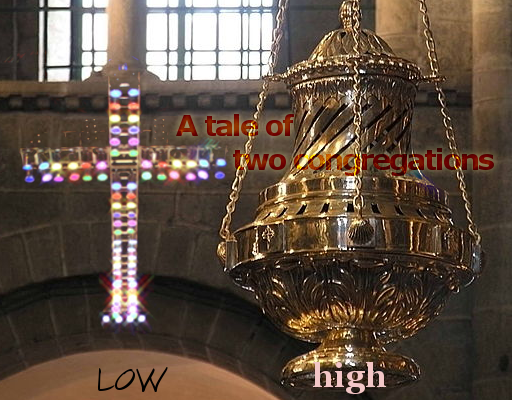In a growing church, there once were two congregations, each of them thriving in its own way. The building could have accommodated both groups at once – in fact, there were sometimes joint services. But you couldn’t have that too often. Oh, no: the styles of worship were too different. The late morning group was quite pedantic about following proper liturgy and was used to smells and bells; but the early morning group was of the happy clappy persuasion. And let’s not talk about the evening service, designed for those who couldn’t or wouldn’t get up early on a Sunday. After all, it is meant to be a day off, right?
 Photo credits: Wikimedia users Rafael Faria and Luis Miguel Bugallo Sánchez, used under CC license
Photo credits: Wikimedia users Rafael Faria and Luis Miguel Bugallo Sánchez, used under CC license
And so joint services, when they happened, were a matter of compromise: we’ll have some modern music, but we’ll also read off Common Worship. And we’ll robe up, but we won’t use the kneelers for communion. Elements for the high church congregation, elements to give a spiritual high to the late morning group. And while everyone could see the other group needed to be accommodated in joint services, it didn’t mean they liked it. Or that they could engage with worship very well.
While each congregation was left to enjoy its particular way of worship, they experimented more and more into each direction, until visitors would believe there were two different churches meeting in the same building.
It is easy – relatively speaking – to satisfy the expectations of a congregation in terms of how the service is ordered, when those expectations are broadly similar across the board. It is even easier to avoid the particular tidbits that you know will annoy a specific individual within your congregation – for instance, blacklisting a hymn on non-theological considerations. We don’t sing about the wrath of God because so and so doesn’t like it and will kick up a fuss if we do.
It is much harder to satisfy the expectations of a mixed congregation.
But if that’s what we’re trying to do, our focus is wrong: it’s a primary focus on the congregation. Of course, the congregation is important, but what matters more is who we worship. Hopefully, this is a given and the purpose of the services and the ways in which they are ordered all point to that; but where disagreements arise, they lead to the largest headaches and end up, inevitably, becoming the focus of attention. Instead of Christ. The same Christ, who is both fully human and fully divine, is not a compromise between humanity and divinity. He is not taking this part of humanity at the expense of that one, he is not accepting this attribute of divinity at the expense of another one. He is both at once, in a kiss between heaven and earth.
If we can accept this meeting place, then our services can also reflect that. We can order a service drawing elements from both styles of worship – not in order to try to please both, but in order to enrich our worship of Christ. Not in order to be inclusive, but in order to reflect this joining of the human and the divine.
Then, it won’t matter whether it’s more high or more low church. The joint service will be a celebration of the diversity of God’s people, meeting together as Christ’s body, and becoming fully high and fully low at the same time. And slowly, all services will be joint services, and the unity of the Church will be made visible.
—
Of course, this is easier said than done. There are specific rules that should be followed for high church services under canon law (as far as I know, but do correct me if I’m wrong), and until there is a change in how we view Common Worship and other ASBs, it will not be possible to incorporate elements from all congregations in a meaningful way.
